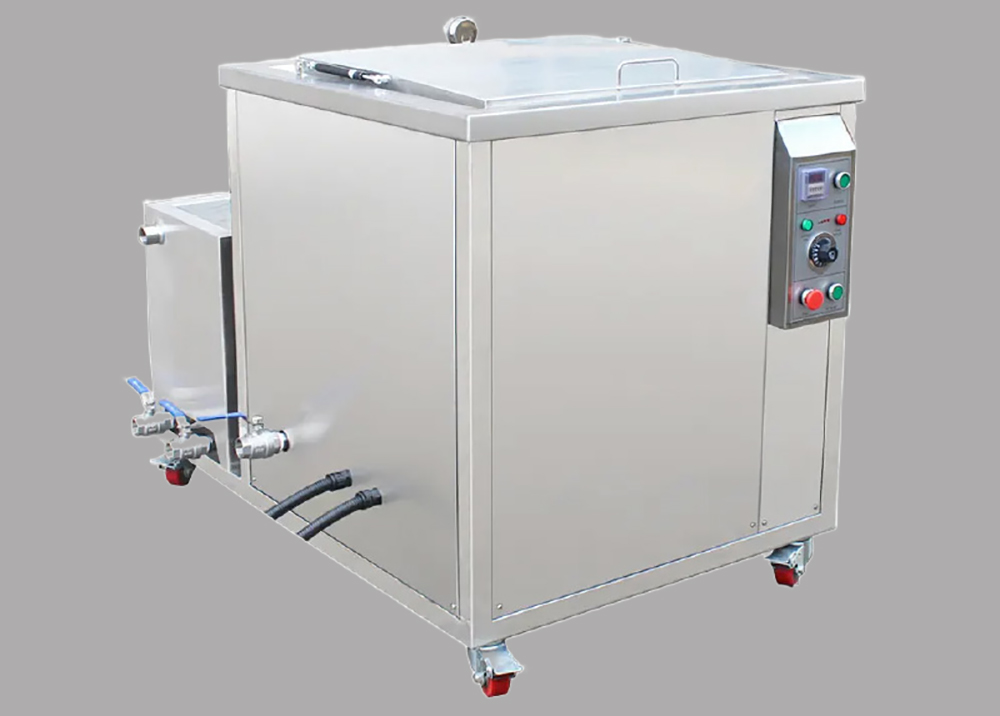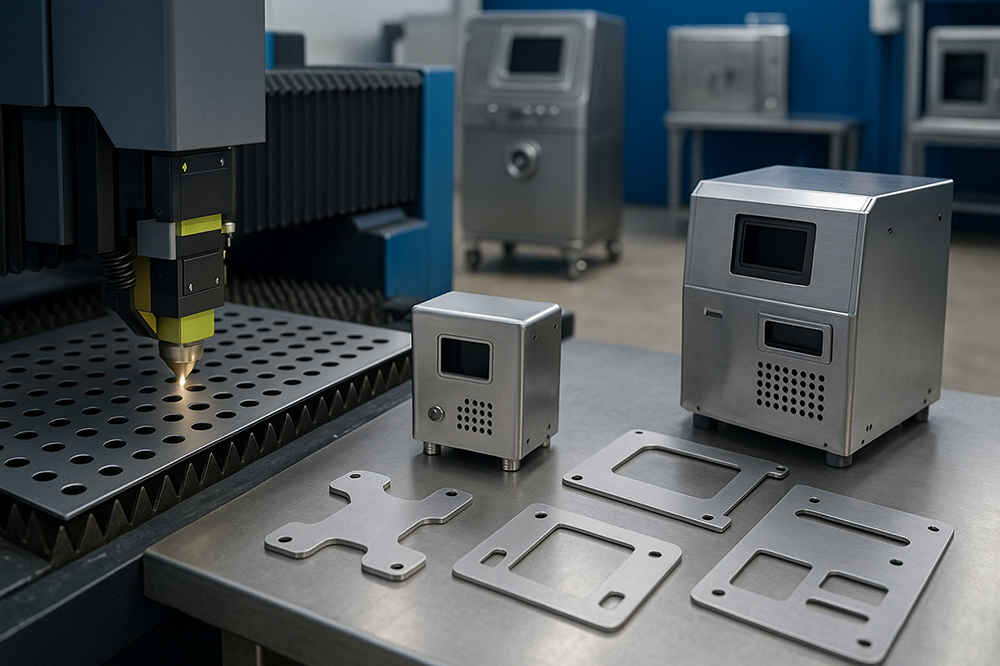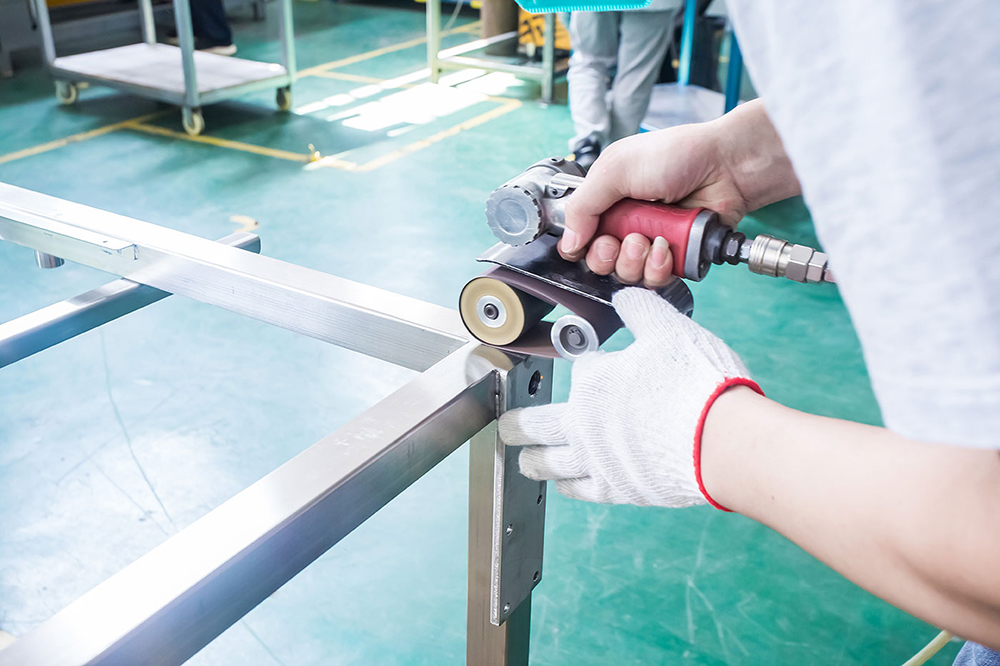Precision Hardware Customized Solutions Manufacturer
Medical device manufacturing demands exacting precision and reliability, and medical sheet metal fabrication plays a vital part in meeting these needs. Medical equipment can be “the difference between life and death,” so even minute deviations in a component can spell disaster.
Sheet metal fabrication produces critical parts—such as equipment housings, surgical instrument trays, and support frames—that must function flawlessly under stringent conditions. Key materials include stainless steel 316L and aluminum alloys, prized for their corrosion resistance and biocompatibility.
For instance, 316L stainless steel can withstand high-heat sterilization and harsh cleaning chemicals without corroding. As a result, reputable fabricators maintain strict quality systems (e.g. ISO 9001 : 2015 certification) to ensure every part is safe, durable, and compliant. In this context, medical sheet metal fabrication underpins the safety and performance of modern healthcare devices.

Contents
Medical sheet metal fabrication is used in a wide range of healthcare equipment. Manufacturers commonly produce components like custom instrument covers, equipment carts, and IV stands—all tailored to medical specifications. Other typical products include rugged enclosures for diagnostic devices, hospital cabinetry, and stainless-steel trays for surgical tools. Sheet metal fabrication also enables the creation of structural frames and racks for lab equipment.
For example, custom tubular steel frames serve as carts, test-tube racks, and supply carts in hospitals. These parts must meet exacting production standards because patient safety depends on their reliability. In practice, medical sheet metal fabricators work from customer drawings to bend, cut, and weld high-grade metals into assemblies that often have very tight tolerances and exacting finish requirements.
Common medical sheet metal components include:
Custom instrument covers and enclosures, precisely cut and formed to protect sensitive electronics.
Medical carts, cabinets and IV stands, which must support loads and roll smoothly.
Surgical tool trays and work surfaces, requiring a smooth, hygienic finish.
Support frames and rack structures, often made from stainless steel tubing or sheet for durable, sterile storage.
Each of these applications leverages the strength and formability of metal. Whether it’s a ventilator housing or a bioanalysis machine frame, sheet metal fabrication provides the rigid, stable construction medical devices need.
The most common metals used in medical sheet metal fabrication are stainless steel and aluminum. Stainless steel – particularly grades like 316L – is ideal because of its exceptional corrosion resistance and biocompatibility. It can endure frequent sterilization (autoclaving, chemical disinfectants, etc.) without degradation, maintaining a polished, sterile surface.
For example, one fabricator notes that stainless 316 “withstands high heat and harsh chemicals used in medical sterilization processes”, making it suitable for surgical tools and trays. Aluminum alloys (such as 5052 or 6061) are also widely used; they offer a lighter-weight alternative with good formability and weldability. Aluminum’s strength-to-weight ratio, recyclability, and thermal conductivity make it advantageous for portable medical devices and housings.
Other specialty metals are used when specific properties are needed. Titanium, for instance, is chosen for implants or devices that require ultimate biocompatibility. Many fabricators report working with a variety of medical-grade materials – from cold-rolled steel to titanium – and can source exotic alloys on request.
Regardless of the metal, all sheet-formed parts must meet healthcare standards. Medical sheet metal components are often engineered to prevent contamination (smooth surfaces, rounded edges) and must pass biocompatibility testing. In summary, medical sheet metal fabrication leverages metals that combine structural performance with patient-safe properties.

Sheet metal fabrication for medical devices employs precise forming and assembly processes. Flat metal blanks are cut by high-speed lasers, CNC punches, or water jets to create accurate contours and holes. Fabricators use CNC press brakes and automated bending cells to form complex 3D shapes with consistent angles.
For example, a laser cutter can rapidly produce enclosures with dozens of holes and slots in a single setup, while a press brake will bend each flange or tab to tolerance. Many medical fabricators maintain tolerances of ±0.001 inch on internal features and work with sheet as thin as 0.003 inches, ensuring parts fit together perfectly. After forming, parts are often welded and assembled. Skilled welders (TIG/MIG) fuse components into rigid assemblies, while robotic equipment might spot-weld or insert hardware.
Because medical designs often evolve, sheet metal fabrication also allows flexibility. Unlike plastic molding, sheet metal tooling changes can be made quickly by reprogramming machines or fabricating new dies. In fact, one manufacturer notes that modifying a metal design (adding an embossed logo or knockout) typically involves only minor adjustments, whereas plastic prototypes might need a whole new mold.
This flexibility speeds up development and reduces costs. Fabrication shops frequently include in-house tool and die capabilities to fast-track prototyping. As reported by one supplier, having an on-site tool shop “increases production speeds” by eliminating external delays.
Once components are fabricated, they undergo inspection and any necessary secondary operations. Many sheet metal shops provide value-added services such as deburring, laser engraving, and assembly. These services turn raw metal parts into complete, ready-to-use units. By coordinating forming, welding, and finishing under one roof, a fabricator can deliver fully assembled sub-assemblies or even complete enclosures (for example, a medical device cabinet with doors and wiring already installed). This integrated approach streamlines the production of complex medical systems.
After forming and assembly, the surface finish of a medical metal part is critically important. The right finish can dramatically improve corrosion resistance, cleanability, and biocompatibility. Common surface finishing techniques for medical sheet metal fabrication include passivation, electropolishing, anodizing, powder coating, and sandblasting/bead blasting. Each process enhances the metal in a specific way:
Passivation is a chemical process applied to stainless steel components. It typically involves treating the metal in an acid bath (often nitric or citric acid) to dissolve any free iron or surface contaminants introduced during fabrication. Removing this free iron leaves behind a stronger chromium-oxide “passive” layer on the surface. In medical applications, this passive film is highly desirable because it is chemically inert and prevents future rust.
In effect, passivation makes a stainless steel part even less reactive. For example, after fabrication, a surgical tray is often pickled and passivated so that it withstands aggressive sterilization chemicals without corroding. This is so important that many medical device standards (including FDA and ISO 13485 regulations) explicitly require passivation of stainless components. In summary, passivation ensures that medical steel parts remain rust-free and biocompatible over their lifetime.
Electropolishing is an electrolytic polishing process that smooths metal surfaces at a microscopic level. In practice, the metal part serves as an anode in an acid bath (commonly a mixture of sulfuric and phosphoric acid). A controlled electrical current causes the tiny peaks on the metal surface to dissolve faster than the valleys. The result is a mirror-like, ultra-smooth finish. In the medical industry, electropolishing is prized because it removes microscopic asperities and reduces the surface roughness (Ra) of stainless steel parts.
This eliminates hidden nooks where bacteria could adhere. Indeed, electropolished instruments and implants are easier to sterilize and meet stringent hygiene standards. As one industry source notes, electropolishing can even function as a sterilization step in itself, helping to remove contaminants on surgical components.
The polished finish also enhances corrosion resistance by forming a uniform oxide layer. For example, needles, trays, and instrument shafts are often electropolished to provide a bright, sanitary finish that lasts through repetitive cleanings. Overall, electropolishing in medical sheet metal fabrication produces precision parts whose surfaces resist bacterial adhesion and corrosion.
Anodizing is an electrolytic conversion process used mainly on aluminum components. It thickens the natural oxide layer on the aluminum surface. In a typical anodizing bath (sulfuric acid electrolyte), the aluminum part is made the anode; as current passes, oxygen ions combine with the metal to form a tough aluminum oxide finish. Unlike a paint or coating, this oxide layer is integral to the metal, so it does not chip or flake.
In medical device fabrication, anodizing provides both protection and functionality. Type II (sulfuric) anodizing yields a hard, porous oxide finish that can be dyed in various colors. This is useful for color-coding equipment (emergency devices might use bright orange or blue, for example) while also boosting corrosion and wear resistance. Type III (hardcoat) anodizing produces an even thicker, more wear-resistant layer (often 3–4 times thicker) for extreme durability.
Properly anodized medical parts can endure dozens of sterilization cycles (steam, peroxide, alkaline cleaners) without losing their coating. In short, anodizing in medical sheet metal fabrication creates chemically resilient and abrasion-resistant surfaces, often with vivid, permanent coloration.
Powder coating involves applying a dry powder (usually thermoplastic or epoxy) electrostatically to a metal surface, then baking it to form a continuous film. The result is a hard, non-porous coating bonded to the part. In medical applications, powder coating is valued for its durability and ease of maintenance. The baked-on finish resists chipping, scratching, and fading far better than liquid paint.
For example, a supply cart or equipment cabinet might be finished in bright powder-coated colors to withstand daily wear while providing visual identification. Importantly, powder-coated surfaces are completely smooth and uniform (free of brush marks or drips). This smoothness, combined with the coating’s non-porous nature, makes the surface easy to wipe clean and prevents bacteria from embedding.
Medical cart manufacturers note that non-porous powder coatings give an extra layer of protection against contamination. Overall, powder coating provides a tough, hygienic outer layer that extends the life of metal parts and allows for customized colors and logos.
Sandblasting (or bead blasting when using fine glass beads) is a mechanical surface finishing method. In this process, abrasive media is propelled at high pressure onto the metal surface, cleaning it and imparting a uniform texture. For medical sheet metal fabrication, sandblasting serves multiple purposes. First, it cleans and strengthens the part without significant material removal; one source notes it “strengthens aluminum components and improves their longevity”.
Second, bead-blasted finishes are commonly used on surgical instruments and implants to provide a consistent matte texture that reduces glare under bright lights. This matte finish can improve the visibility of fine details and prevent reflections in operating rooms. Third, blasting is frequently a preparatory step before coatings: a blasted surface provides better adhesion for paints, anodized layers, or powder coats.
Manufacturers report that medical device surfaces treated by bead blasting are exceptionally clean and free of mill scale, which is crucial before sterilization. In short, sandblasting in medical fabrication yields a uniform, non-reflective finish and prepares components for subsequent protective coatings.
After fabrication and finishing, choosing the right combination of processes depends on the application. For example:
Corrosion resistance: achieved by passivation (stainless steel) or anodizing (aluminum).
Sterilization compatibility: ensured by electropolishing (to reduce crevices) and passivation.
Aesthetic and branding: accomplished with anodized colors or custom powder coating.
Durability and wear resistance: enhanced by hard anodizing or tough powder coatings.
By aligning finishes with functional goals, medical sheet metal fabricators make sure parts not only comply with industry standards, but also enhance device longevity and patient safety.

When it comes to medical sheet metal fabrication, Shengwo stands out as a top choice. Shengwo brings decades of experience in high-precision fabrication for healthcare equipment. Our facility is equipped with advanced CNC lasers, press brakes, and automated welding stations to produce parts with ultra-tight tolerances (often within ±0.001″). We work with certified medical-grade materials (316L stainless steel, aluminum alloys, etc.) and our processes follow ISO 13485/9001 quality standards. This means every component is traced and inspected, giving customers confidence in consistent, safe results.
Key reasons to partner with Shengwo include:
Medical Expertise: Our engineers understand biocompatibility and cleanroom requirements, ensuring fabricated parts support critical medical functions.
Full-Service Fabrication: We offer end-to-end capabilities – from CNC forming and laser cutting to secondary processes (passivation, electropolishing, anodizing, powder coating and more). This in-house finishing means quicker turnaround and uniform quality.
Strict Quality Assurance: Shengwo maintains ISO 9001 certification and FDA-registered processes. Every project follows detailed documentation and inspection protocols for 100% traceability.
Fast, Responsive Service: We provide rapid quoting and prototyping. Our in-house toolshop and robust equipment allow fast design iterations and small to medium production runs without delays.
Customization and Support: We tailor each sheet metal solution to your needs, whether it’s a small surgical fixture or a full instrument cabinet. Our engineers work closely with clients on design for manufacturability to optimize cost and performance.
Choosing Shengwo means partnering with a medical manufacturing expert committed to excellence. Our successful track record includes supplying components for ventilators, imaging machines, surgical carts, and more. We ensure that every sheet metal part we make enhances product safety, durability and functionality.
Ready to discuss your project? Contact Shengwo today for a detailed quote or technical consultation. Our team is standing by to help with your next medical device manufacturing project, ensuring you get high-quality fabricated parts on time and within budget.